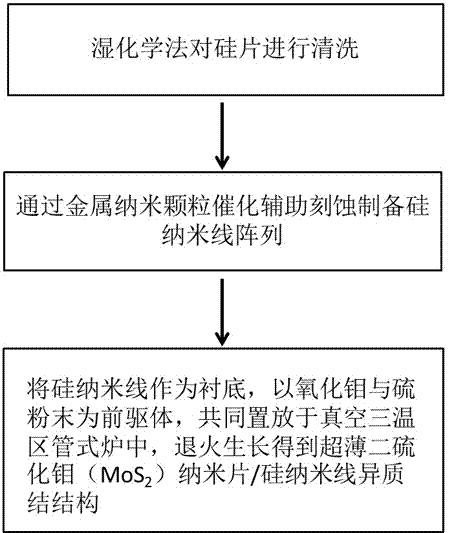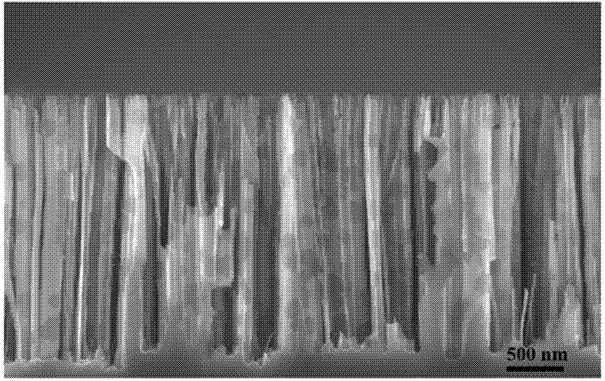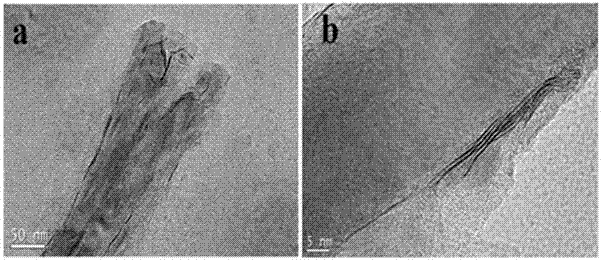Preparation method of ultrathin molybdenum disulfide nanosheet/silicon nanowire heterojunction structure
A technology of silicon nanowires and molybdenum disulfide, applied in chemical instruments and methods, chemical/physical processes, physical/chemical process catalysts, etc., can solve the problems of difficult large-scale application of catalysts, scarcity of precious metal resources, and low catalytic activity. Achieve the effect of increasing the density of catalytic active sites, unique light trapping, and good photocatalytic activity
- Summary
- Abstract
- Description
- Claims
- Application Information
AI Technical Summary
Problems solved by technology
Method used
Image
Examples
Embodiment 1
[0039] This application example provides a method for preparing ultra-thin molybdenum disulfide (MoS 2 ) method of nanosheet / silicon nanowire heterojunction structure material, the schematic diagram of the preparation process is as follows figure 2 , where (a) represents the silicon wafer after wet chemical cleaning; (b) represents the silicon nanowire array obtained by metal-assisted etching; (c) represents the ultra-thin molybdenum disulfide (MoS 2 ) nanosheet / silicon nanowire heterojunction structure.
[0040] Such as figure 1 As shown, the technical solution of the present invention is further described below.
[0041] (1) Cleaning of silicon wafers: Cut the P-type (100) oriented intrinsic silicon with a resistivity of 1~10Ω·cm on one side and cut it into 2×2 cm 2 Put the silicon wafer into acetone, ethanol, and deionized water for 10 minutes to remove the oil on the surface, then put it into a mixture of concentrated sulfuric acid and 40% hydrogen peroxide with a volum...
Embodiment 2
[0045] Test of Hydrogen Production Performance of Photoelectrocatalytic Water Splitting
[0046] The photoelectrocatalytic activity test and analysis was completed on a CHI660E electrochemical workstation, using a three-electrode test system. Silicon nanowires or ultrathin molybdenum disulfide (MoS 2 ) nanosheet / silicon nanowire heterojunction structure as the working electrode, the auxiliary electrode is a platinum wire electrode; the reference electrode is a saturated silver-silver chloride electrode. The electrolyte is a 0.5M sulfuric acid solution. 1 simulated sunlight for testing is achieved by using Xe lamps at 100mW / cm 2 realized under light.
[0047] Figure 6 It is the ultra-thin molybdenum disulfide (MoS) described in the present invention 2 ) Polarization curves of nanosheet / silicon nanowire heterojunction structure and pure silicon nanowire under light and dark conditions respectively, the applied bias voltage is -0.35~0.27V vs. s. From the data in the figur...
PUM
| Property | Measurement | Unit |
|---|---|---|
| Resistivity | aaaaa | aaaaa |
| Photocurrent | aaaaa | aaaaa |
Abstract
Description
Claims
Application Information
 Login to View More
Login to View More - R&D
- Intellectual Property
- Life Sciences
- Materials
- Tech Scout
- Unparalleled Data Quality
- Higher Quality Content
- 60% Fewer Hallucinations
Browse by: Latest US Patents, China's latest patents, Technical Efficacy Thesaurus, Application Domain, Technology Topic, Popular Technical Reports.
© 2025 PatSnap. All rights reserved.Legal|Privacy policy|Modern Slavery Act Transparency Statement|Sitemap|About US| Contact US: help@patsnap.com



